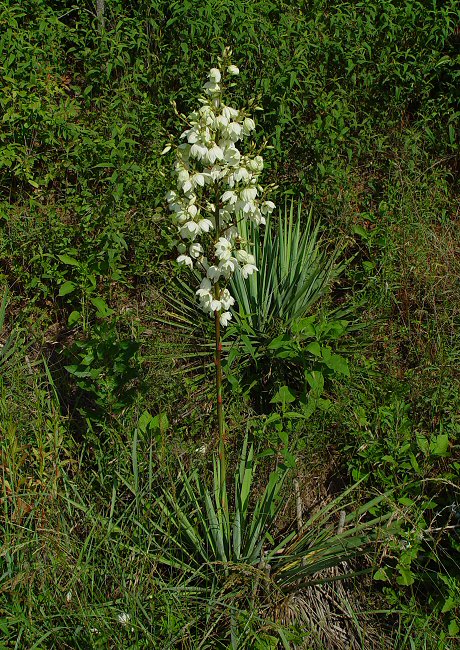Yucca smalliana Fernald
Spanish Bayonet

Introduced
CC = *
CW = 5
MOC = 0
© DETenaglia
Yucca smalliana FernaldSpanish Bayonet | |
 |
Introduced CC = * CW = 5 MOC = 0 |
© DETenaglia |
|
Family - Agavaceae Habit - Herbaceous or shrubby perennial. Stems - Reduced to a woody base, to 20 cm long. Flowering stem to 2.5 m tall. Leaves - All basal, linear, 15-80 cm long, 2-7 cm wide, somewhat glaucous, straight or lax, leathery, linear-lanceolate to linear-oblanceolate with a short, stout spine at the tip and white to tan, peeling, fibrous margins.
Inflorescence - Large terminal panicle to 2.5 m, erect, with the base of the flowering portion raised above the leaves. Pedicels 1.1 cm long, densely pubescent.
Flowers - Tepals 5-7 cm long, ovate, the tips tapered to a point, green-or yellow-white, sometimes tinged pale purple, glabrous, succulent. Stamens 6, usually included, the anthers sagittate. Ovary superior, 3-locular, the style short, the stigma 3-lobed to nearly entire.
Fruit - 6 angled capsule to 5 cm long, 3 cm in diameter. Seeds many, flat, 6-8 mm broad.
Flowering - May - August. Habitat - Cultivated but escaping to various localities. Origin - Native of southeastern U.S., considered introduced in Missouri. Lookalikes - Other species of Yucca. Other info. - This species can be found cultivated throughout Missouri, sometimes escaping cultivation and often persisting around former habitations. It is very showy when in bloom and is easily recognizable. The species is distinguished from other yuccas found in Missouri by its paniculate (branched) inflorescences. However, specific identification, as well as discernment of native range, is complicated by widespread and sporadic presence of various unpredictable species and cultivars due to past cultivation events.
Photographs taken off Hwy 60 near Van Buren, MO., 6-5-04 (DETenaglia); also at Weldon Spring Conservation Area, St. Charles County, MO, 6-24-2011 and 6-20-2016, near Labadie, Franklin County, MO, 6-7-2019, and Pea Ridge Conservation Area, Washington County, MO, 2-23-2020 (SRTurner). |